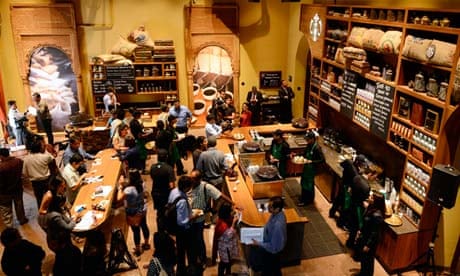During the past 10 days, sweaty queues of up to 50 people have formed outside an old colonial building in downtown Mumbai, while a security guard operates a one-in-one-out policy. These hopefuls are not trying to get into an edgy new nightclub or shake hands with a visiting politician. They are waiting for up to an hour to go to Starbucks. "There's excitement among everyone," said Akhil Somani, a 27-year-old financial adviser, as he stood in line last weekend. "We have our own coffee brands but this one has had a lot of hype."
Starbucks, the world's largest coffee-shop chain, opened its first branch in India on 19 October. Two more branches – including one in Mumbai's famous Taj Mahal Palace hotel, which has likewise seen dozens of people queuing for a frappuccino – opened last week. With more than 17,600 branches in 61 countries, it is perhaps surprising that the Seattle-based company has only just arrived in India. It entered China in 1999 and has around 600 outlets there.
India is the home of chai, sugary and milky tea ladled into tumblers at street stalls for around five rupees. However, as Indians' disposable incomes rise, cafes are cropping up in large cities. The country's cafe sector is worth $230m (£143m), up from $40m five years ago, according to a report by Technopak, an Indian consultancy. Cafe Coffee Day, a no-frills homegrown chain, dominates the market. The UK's Costa Coffee and the US's The Coffee Bean and Tea Leaf also have a small presence.
The appearance of Starbucks, whose Mumbai branches offer paneer wraps as well as blueberry muffins, also reflects India's increasingly international malls and high streets. More western chains are expected to open branches here in the near future, after constraints on foreign investment were loosened this autumn.
India's coalition government, led by the Congress party, in September relaxed rules on local sourcing for foreign "single-brand retailers" – shops that sell items belonging to one brand. Last November, it scrapped rules stating that such retailers needed to partner with a local company. Following these reforms, Ikea this month applied to open around 25 outlets. Starbucks has entered India through an $80m joint venture with Tata, one of the country's biggest conglomerates, having worked on this deal before the rules changed.
"[The new rules] should be seen as a signal to foreign investors that we are still welcoming them," said Anubhuti Sahay, a senior economist at Standard Chartered. "Two and a half months ago, there was nothing coming from the government but now there's more hope." However, Sahay added that the economy would not benefit for some months, as any new businesses would have to deal with India's vast amounts of red tape before opening outlets.
Opposition parties and independent shopkeepers have held protests in response to the retail reforms. Yet many customers hope foreign brands will result in more choice and better quality, as local businesses will have to fight to retain clients. "More competition is good for the customer," said Somani as he finally managed to enter Starbucks, only to join another queue for the counter.
Some punters are also excited about having famous brands in their city. "We've seen [Starbucks] in films and on TV," said Ritika Nurthy, a 23-year-old software engineer on her first trip to the chain. She cited The Devil Wears Prada, a film in which Meryl Streep plays a tyrannical magazine editor whose assistant brings her coffee every morning. "You get curious and wonder 'what is that?'"

Comments (…)
Sign in or create your Guardian account to join the discussion